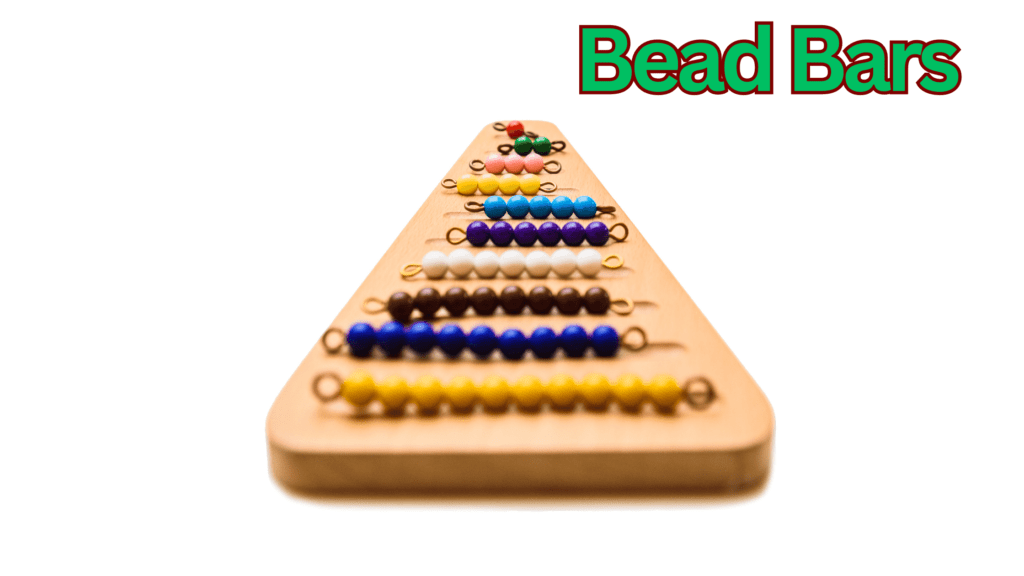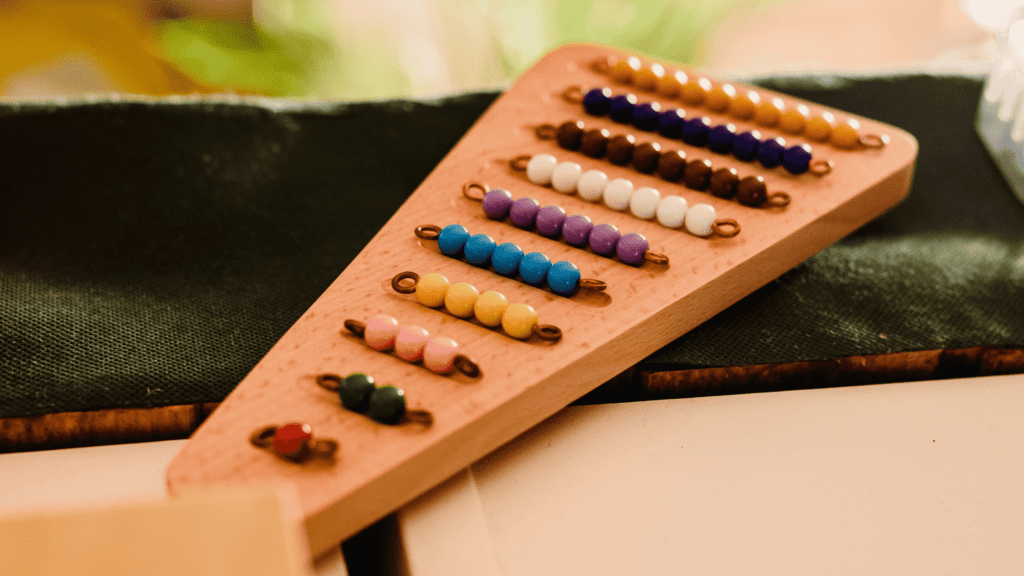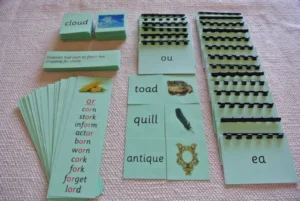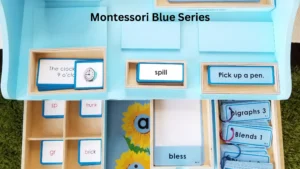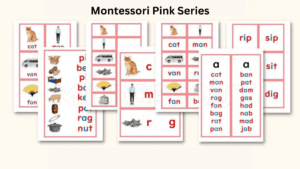This math lesson is designed for 3-6 year old children to help them learn how to count using Montessori bead bars.
Bead bars are a valuable educational resource in Montessori schools that aid children in understanding fundamental mathematical concepts through hands-on exploration. But what are they and how it benefits the children? Let us understand in-depth.
What are Montessori Bead Bars?
Montessori bead bars consist of a series of colored beads, typically made of plastic or wood, organized into sets representing the numbers 1 to 10. Each number is represented by a corresponding quantity of beads on a bar. For instance, the number 5 is represented by five beads on the bead bar. These bars serve as a tangible and visual representation of numbers, making mathematical concepts more accessible to young learners.
The Color Coding of Montessori Bead Bars
Colored bead bars represent 1–10 numbers and each number is represented with unique colors.
- Number 1 is represented with 1 red beads.
- Number 2 is represented with 2 green beads.
- Number 3 is represented with 3 pink beads.
- Number 4 is represented with 4 yellow beads.
- Number 5 is represented with 5 light blue (cyan) beads.
- Number 6 is represented with 6 mauve (violet) beads.
- Number 7 is represented with 7 white beads.
- Number 8 is represented with 8 brown beads.
- Number 9 is represented with 9 dark blue beads.
- Number 10 is represented with 10 mustard (dark yellow beads).
You can also see the below image to see how bead bars look like in a Montessori Curriculum.
How can I use Bead Bars in Math concepts?
Bead bars are math materials that help children in areas such as counting, addition, subtraction, multiplication and division. Based on the complexity of the problems, it is used in both primary and elementary classrooms.
Benefits of Montessori Bead Bars
Montessori bead bars offer a plethora of benefits that contribute to a child’s holistic development and academic success. Let’s explore some of the advantages in detail:
- Foster Independence: The Montessori method places a strong emphasis on fostering independence in children. With bead bars, kids can work at their own pace, allowing them to build confidence in their abilities to solve mathematical problems independently.
- Develop Problem-Solving Skills: Hands-on learning with Montessori bead bars encourages critical thinking and problem-solving skills. When children face mathematical challenges, they learn to analyze, strategize, and arrive at solutions using their knowledge and understanding.
- Build a Strong Foundation: A solid foundation in mathematics is essential for a child’s academic journey. Montessori bead bars provide the groundwork for understanding numbers and arithmetic, setting the stage for more complex math concepts in later years.
- Promote Concentration and Focus: Engaging with Montessori bead bars demands a child’s full attention. This focused approach to learning helps develop concentration skills, which can benefit them in various aspects of life beyond the classroom.
- Instill a Passion for Education: By utilizing bead bars, children are exposed to the thrill of making discoveries and experiencing the gratification of acquiring new skills. This fosters an authentic love for learning that will endure. This passion for knowledge can lead to lifelong learning habits.
How to Introduce Counting Using Montessori bead bars?
We have learned about bead bars and their benefits. Now, we will learn how to count using Montessori bead bars.
Materials required counting using bead bars
- Set of colored bead bars, threaded on a wire, ranging from 1 to 10 beads
- Working mat
- Container: A compact box or small basket designed to neatly store various quantities.
How do Present Bead Bars to the Child?
- Invite the child to the table and ask them to bring bead bars from the math shelf.
- Introduce them to the material by saying “these are bead bars, and today we will learn to count using them”
- Help them learn the color codes mentioned above and number associated with it. For example, 1 number is represented by color red and so on.
- Ask the child to count the number of beads while introducing the nomenclature.
- Testing a child’s understanding of quantities and the corresponding color of beads is crucial. For instance, you could ask the child to identify the bead bar that represents the number 7.
- Let the child answer and again ask them to count the beads in the bar. This way a child will learn the connection between colors and quantities.
Tips to Incorporate Montessori Bead Bars at Home or in the Classroom
Whether you’re a parent or an educator, integrating Montessori bead bars into a child’s learning journey is both rewarding and straightforward. Here are some tips on how to make the most of this powerful educational tool:
- Start with Simple Concepts: Begin with basic numerals and quantities before progressing to more complex numbers. This incremental approach ensures a solid understanding of foundational concepts.
- Use Real-Life Examples: Relate mathematical concepts learned with Montessori bead bars to real-life situations. For instance, during grocery shopping, ask children to count fruits using the bead bars, making the learning experience practical and relevant.
- Encourage Exploration: Allow children to explore the bead bars freely. The more they interact with the beads, the deeper their understanding of numbers and math will become.
- Integrate Games and Activities: Make learning fun by incorporating games and activities that involve the use of Montessori bead bars. This not only keeps children engaged but also reinforces their learning in an enjoyable way.
Engaging Activities with Montessori Bead Bars
- Counting and Sequencing: Encourage children to arrange the bead bars in sequential order, reinforcing the concept of numerical order and one-to-one correspondence.
- Addition and Subtraction: Demonstrate simple addition and subtraction problems using the bead bars. Let children experiment with different combinations to understand mathematical operations.
- Greater than/Less than: Create a playful activity where children compare different bead bars and determine which has more or fewer beads, introducing the concepts of greater than and less than.
- Skip Counting: Use the bead bars to teach skip counting, such as counting by twos, threes, or fives, to enhance number sense and pattern recognition.
Allow the child to explore the Montessori material bead bars and practice counting.
FAQs
- What is the purpose of the Montessori bead stair?
The purpose of the Montessori bead stair is to introduce children to the concept of quantity and numerical order in more visual and concrete way.
- What color are the Montessori beads?
The Montessori beads come in a variety of colors, including red, yellow, blue, green, orange, pink, brown, purple, white, and black.
- What are Montessori bead bars?
The Montessori bead bars consist of colored beads arranged on a wire, ranging from one to ten in quantity. Each bead bar quantity is uniquely represented by a specific color, aiding children in recognizing the corresponding quantity associated with the color of the beads.

